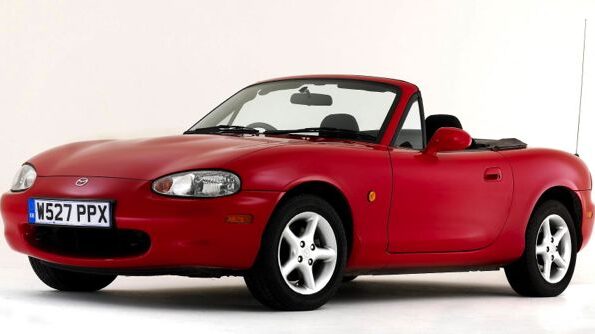Kim Henson takes a close look at another ‘modern classic’ launched since the Western Group of Motoring Writers was established.
With three fascinating decades of our Group now having flown by, in my series of 12 features labelled ‘Back to the Future Classics’, and appearing on our website through 2013, I am looking back at a selection of models seen as especially important.
Together, the vehicles I’ve chosen show how times have changed across the motor industry during the last 30 years, and, I feel, represent “12 of the most significant future classics launched in that time”. So put on your nostalgic spectacles again, and you’ll be amazed …
Quite simply, the Mazda MX-5 is the world’s most successful open top two seater vehicle and that is some accolade, when you think about it.
Yet during the 1980s, and amid scares about safety, many so-called ‘experts’ would have us believe that the traditional open top sports car was no longer fashionable, nor wanted, nor even needed in a performance car market dominated by ‘hot hatches’.
So as the 1980s were dawning, most manufacturers were leaving behind their open top heritage. Fortunately for sports car devotees, Mazda took a different approach (as, so often, this company has done).
In a marketing masterstroke, in early 1990 the firm brought to U.K. buyers what they yearned for – a brand new, soft top, two seater, rear wheel drive sports car, and designated MX-5. (It was also sold around the world, being known as the Eunos Roadster in Japan, and as the Miata in the United States).
It deliberately didn’t re-invent the wheel, but instead won hearts and minds because the model cleverly combined the traditional sports car concept with modern technology and engineering. In addition, as was so often the case with Japanese automotive products of the era, attention had been paid to detail, especially in terms of achieving excellent build quality.
SOLID
The resulting MX-5 felt well put together, was lively and enjoyable to drive, yet also reasonably economical AND dependable. It was well-appointed and relatively comfortable too (although not everyone liked the design of the seats for long-distance motoring) and when compared with many two seaters, had a reasonably spacious luggage boot.
For classic sports car fans used to the ingress into the cockpit of rainwater and draughts, as facts of life on the open road, to have a snug-fitting hood that didn’t (usually) leak was also a real bonus. There were many potential customers who liked the idea of a sports car, but were not so keen on the potential niggles that hitherto had come as part and parcel within the experience of owning a soft top.
The MX-5’s curvaceous styling was distinctive and timeless in an under-stated manner, and the unmistakable, sleek frontal appearance was aided by flush-fitting retractable headlights.
Powering this newcomer was a fuel-injected, twin overhead camshaft 1.6 litre engine, developing 116 bhp and driving through a slick-action five speed manual gearbox. It produced eager, if not breathtaking, performance.
From standstill, the new Mazda was capable of reaching 60 mph in approximately 9.5 seconds, and ultimately the car could exceed 115 mph. More important for many buyers for real-life everyday motoring was the car’s ability to cruise easily on motorways, and its inherently positive handling, which helped to make the car such fun to drive
Standard-fit power-assisted steering helped make easy work of low speed driving in tight spaces, and the double wishbone independent suspension at both front and rear provided a commendable ride quality that was unexpected by many, and certainly more compliant than that of most traditional sports cars.
WELL-EQUIPPED
Standard equipment levels were impressive, with electrically-operated windows, high backed sports seats and a Clarion radio/cassette player stereo system all coming as part of the deal – and the new MX-5 was priced at a competitive £14,249.

For those seeking a faster experience, the 1991 Mazda-approved turbocharged Brodie Britain Racing (BBR) version developed 150 bhp. Just 850 examples were produced.
Many ‘special edition’ variants with standard engines (but differing mainly in paintwork and trim details) were sold in Britain too. Various ‘import’ models are also often encountered.
From the spring of 1994 the MX-5’s engine capacity was increased to 1.8 litres (the new motor being derived from Mazda’s 323 unit). This resulted in an improved power output of 130 bhp, plus greater torque (although on paper the performance figures were much the same as for the 1.6 version). Chassis improvements and suspension modifications enhanced body stiffness and cornering potential, respectively.
As already mentioned, all MX-5s were comprehensively equipped, and particularly so by comparison with most traditional sports cars, and the 1.8i S (from 1994) was even better endowed with standard fittings.
In 1997 the last of the ‘Mark 1s’ was produced, and then a new MX-5 (Mark 2) arrived.
By contrast with the original model, the restyled newcomer had lost the retractable headlamps and gained a glass, heated rear window.
CHECKS
MX-5s are known and loved for their reliability and excellent build quality. Even so, perfect they are not, and the earliest examples are nearly a quarter of a century old now, so careful buying checks need to be carried out to ensure that the car is in good condition.
Rust can get a grip, especially in the rear ends of the sills, within the body structure ahead of the rear wheels, and around the bases of the windscreen pillars.
The sill drain apertures (very small) and the drain tubes within the rear bodywork (intended to take rainwater away from the hood) are prone to becoming blocked with debris, and these need to be unobstructed to prevent the formation and spread of rust. In addition, the paint finish on early MX-5s requires frequent attention to keep it looking good.
Mechanically-speaking these Mazdas are tough machines, and the smooth-running, willing engines will run many years without problems, if given diligent and sympathetic maintenance.
Particularly important are regular engine oil and filter changes, fitting a new cam (timing) belt at least every five years or 60,000 miles (whichever comes first) and ensuring that the anti-freeze mixture in the cooling system is always up to strength and in excellent condition; if not, the aluminium cylinder head will suffer.
The retractable headlamps and electrically operated windows are generally reliable, although problems with the drive motors are not unknown.
On examples (usually Eunos imports) equipped with air conditioning, this needs to function correctly.
Eunos imports are often disguised by having British ‘MX-5’ badges added. However, to confirm which model you are actually viewing, in addition to the badging there are other give-aways…
Most importantly, look at the underbonnet plate (at the rear of the engine bay) showing the VIN, which for a UK model should be a 17 digit number commencing ‘JMZ’. A little further into the UK VIN code will be a letter denoting the engine type: ‘B’ means an original 1.6 litre unit, whereas ‘D’ indicates a 1.8 litre motor.
By contrast, the VIN on an import will be a 10 digit number starting with ‘NA6’ (1.6 litre) or ‘NA8’ (1.8 litre). A ‘square’ rear number plate is a further indication of an import version.
VERDICT
A truly impressive modern classic for open top two seater enjoyment. The MX-5 is well-built, comfortable, reliable, fun to own and to use, and in most respects easy to look after, with good availability of spares. Early examples are still affordable too.

(Oh no, what am I saying? I’ve almost talked myself into buying another car…).
Images sourced thanks to Virtual Motorpix – © Kim Henson

